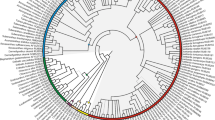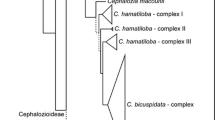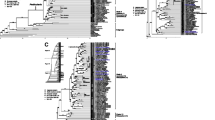Abstract
Crassulaceae (orpine or stonecrop family) is the most species-rich (ca. 1400 spp) family in the order Saxifragales. Most members of the family are succulent plants. Phenotypic diversity and large number of species complicates systematics of the family and obscures reconstruction of relationship within it. Phylogenetic analyzes based on morphological and molecular markers placed Crassulaceae as one of the crown clades of Saxifragales. In this contribution a review of phylogenetic studies on the family Crassulaceae, based on DNA nucleotide sequence comparisons is presented; major clades established in the family are characterised; their structure and polyphylesis of some genera are discussed. It is shown that the traditional taxonomic structure of Crassulaceae contradicts pattern of phylogenetic relationships between its members. We critically analyzed recent taxonomic systems of the family and stress that homoplasy of morphological characters does not allow to use them to reconstruct relationships between crassulacean taxa even at the low taxonomic levels.
Similar content being viewed by others
References
Eggli U. 2003. Illustrated handbook of succulent plants: Crassulaceae. Berlin: Springer.
Ham R.C.H.J., t’ Hart H. 1998. Phylogenetic relationships in the Crassulaceae inferred from chloroplast DNA restriction-site variation. Am. J. Bot. 85, 123–134.
Keeley J.E. 1998. Photosynthetic pathway diversity in a seasonal pool community. Funct. Ecol. 13, 106–118.
Keeley J.E., Rundel P.W. 2003. Evolution of CAM and C4 carbon concentrating mechanisms. Int. J. Plant Sci. 164, 55–77.
De Candolle A.P. 1830. Penthorum. In: Prodromus systematis naturalis regni vegetabilis, vol. 3. Ed. De Candolle A.P. Paris: Truettel and Wurtz, p. 414.
Engler A. 1930. Saxifragaceae. In: Die natürlichen Pflanzenfamilien, vol 18a, 2nd ed. Eds Engler A., Prantl K. Leipzig: Wilhelm Engelmann, pp. 74–226.
Takhtajan A. 1980. Outline of the classification of flowering plants (Magnoliophyta). Bot. Rev. 46, 225–359, 225–359.
Cronquist A. 1991. An integrated system of classification of flowering plants. N.Y.: Columbia Univ. Press.
Thorne R.F. 2000. The classification and geography of the flowering plants: Dicotyledons of the class Angiospermae (Subclasses Magnoliidae, Ranunculidae, Caryophyllidae, Dilleniidae, Rosidae, Asteridae, and Lamiidae). Bot. Rev. 66, 441–647.
Hoot S.B., Magallo S.N., Crane P.R. 1999. Phylogeny of basal eudicots based on three molecular datasets: atpB, rbcL, and 18S nuclear ribosomal DNA sequences. Ann. Missouri Bot. Gard. 86, 1–32.
Qiu Y.L., Lee J., Bernasconi-Quadroni F., Soltis D.E., Soltis P.S., Zanis M., Zimmer E.A., Chen Z.D., Savolainen V., Chase M.W. 1999. The earliest angiosperms: Evidence from mitochondrial, plastid, and nuclear genomes. Nature. 402, 404–407.
Savolainen V., Chase M.W., Hoot S.B., Morton C.M., Soltis D.E., Bayer C. 2000. Phylogenetics of flowering plants based upon a combined analysis of plastid atpB and rbcL gene sequences. Syst. Biol. 49, 306–362.
Soltis D.E., Soltis P.S., Chase M.W., et al. 2000. Angiosperm phylogeny inferred from a combined data set of 18S rDNA, rbcL, and atpB sequences. Bot. J. Linn. Soc. 133, 381–461.
Fishbein M., Hibsch-Jetter C., Soltis D.E., Hufford L. 2001. Phylogeny of Saxifragales (angiosperms, eudicots): Analysis of a rapid, ancient radiation. Syst. Biol. 50, 817–847.
Fishbein M., Soltis D.E. 2004. Further resolution of the rapid radiation of Saxifragales (Angiosperms, Eudicots) supported by mixed-model Bayesian analysis. Syst. Bot. 29, 883–891.
Wikström N., Savolainen V., Chase M.W. 2001. Evolution of the angiosperms: Calibrating the tree. Proc. Roy. Soc. Lond. B: Bio. 268, 2211–2220.
Crepet W.L., Nixon K.C., Gandolfo M.A. 2004. Fossil evidence and phylogeny: The age of major angiosperm clades based on mesofossil and macrofossil evidence from Cretaceous deposits. Am. J. Bot. 91, 1666–1682.
Mort M.E., Soltis D.E., Soltis P.S., Francisco-Ortega J., Santos-Guerra A. 2001. Phylogenetic relationships and evolution of Crassulaceae inferred from matK sequence data. Am. J. Bot. 88, 76–91.
’t Hart H., Eggli U. 1995. Introduction: evolution of Crassulaceae systematics. In: Evolution and systematics of the Crassulaceae. Eds. ’t Hart H., Eggli U. Leiden: Backhuys, pp. 7–15.
Berger A. 1930. Crassulaseae. In: Die natürlichen Pflanzenfamilien, vol 18a, 2nd ed. Eds. Engler A., Prantl K. Leipzig, Germany: Wilhelm Engelmann, pp. 352–485.
Uhl C.H. 1963. Chromosomes and phylogeny of the Crassulaceae. Cact. Succ. J. 35, 80–84.
Ohba H. 1978. Generic and infrageneric classification of the Old World Sedoideae (Crassulaceae). J. Fac. Sci., Univ. Tokyo: Sec. III. 12, 139–198.
Eggli U., t’ Hart H., Nyffeler R. 1995. Towards a consensus classification of the Crassulaceae. In: Evolution and Systematics of the Crassulaceae. Eds. ’t Hart H., Eggli U. Leiden: Backhuys, pp. 173–192.
Takhtajan A.L. 1987. Sistema magnoliofitov (The System of Magnoliophytes). Leningrad: Nauka.
Takhtajan A. 1997. Diversity and Classification of Flowering Plants. N.Y.: Columbia Univ. Press.
Albert V.A., Williams S.E., Chase M.W. 1992. Carnivorous plants: Phylogeny and structural evolution. Science. 257, 1491–1495.
Grund C., Jensen U. 1981. Systematic relationships of Saxifragales revealed by serological characteristics of seed proteins. Plant Syst. Evol. 137, 1–22.
Hufford L. 1992. Rosidae and their relationships to other nonmagnoliid dicotyledons: A phylogenetic analysis using morphological and chemical data. Ann. Missouri Bot. Gard. 79, 218–248.
Chase M.W., Soltis D.E., Olmstead R.G., et al. 1993. Phylogenetics of seed plants: An analysis of nucleotide sequences from the plastid gene rbcL. Ann. Missouri Bot. Gard. 80, 528–580.
Morgan D.R., Soltis D.E. 1993. Phylogenetic relationships among members of Saxifragaceae sensu lato based on rbcL sequence data. Ann. Missouri Bot. Gard. 80, 631–660.
Soltis D.E., Morgan D.R., Grable A., Soltis P.S., Kuzoff R. 1993. Molecular systematics of Saxifragaceae sensu stricto. Am. J. Bot. 80, 1056–1081.
Soltis D.E., Soltis P.S., Nickrent D.L., et al. 1997. Angiosperm phylogeny inferred from 18S ribosomal DNA sequences. Ann. Missouri Bot. Gard. 84, 1–49.
Soltis D.E., Soltis P.S. 1997. Phylogenetic relationships in Saxifragaceae sensu lato: A comparison of topologies based on 18S rDNA and rbcL sequences. Am. J. Bot. 84, 504–522.
Ueda K., Hanyuda T., Nakano A., Shiuchi T., Seo A., Okubo H., Hotta M. 1997. Molecular phylogenetic position of Podostemaceae, a marvelous aquatic flowering plant family. J. Plant Res. 110, 87–92.
Nickrent D.L., Der J.P., Anderson F.E. 2005. Discovery of the photosynthetic relatives of the “Maltese mushroom” Cynomorium. BMC Evol. Biol. 5, 38.
Soltis D.E., Mort M.E., Soltis P.S., Hibsch-Jetter C., Zimmer E.A., Morgan D. 1999. Phylogenetic relationships of the enigmatic angiosperm family Podostemaceae inferred from 18S rDNA and rbcL sequence data. Mol. Phyl. Evol. 11, 261–272.
Soltis D.E., Soltis P.S., Endress P.K, Chase M.W. 2005. Phylogeny and Evolution of Angiosperms. Sunderland: Sinauer Assoc.
Ham R.C.H.J. 1995. Phylogenetic relationships in the Crassulaceae inferred from chloroplast DNA variation. In: Evolution and Systematics of the Crassulaceae. Eds. ’t Hart H., Eggli U. Leiden: Backhuys, pp. 16–29
’t Hart H. 1995. Classification of the Crassulaceae. In: Evolution and Systematics of the Crassulaceae. Eds. t’Hart H., Eggli U. Leiden: Backhuys, pp. 159–172.
Mayuzumi S., Ohba H. 2004. The phylogenetic position of East Asian Sedoideae (Crassulaceae) inferred from chloroplast and nuclear DNA sequences. Syst. Bot. 29, 587–598.
Gontcharova S.B., Gontcharov A.A., Stephenson R. 2008. Analysis of phylogenetic relationships in the family Crassulaceae based on nuclear ITS rDNA sequences. Bot. Zh. 93, 96–113.
Gontcharova S.B., Gontcharov A.A. 2004. Sequence and secondary structure evolution of ITS rDNA in the family Crassulaceae. In: Evolutionary Botany of Certain Plant-Groups of the East Eurasian Floristic Element Related to Japanese Flora on the Basis of Chromosomes. Abstract Book. Hiroshima, Japan, pp. 32–34
Pollock D.D., Zwickl D.J., McGuire J.A., Hillis D.M. 2002. Increased taxon sampling is advantageous for phylogenetic inference. Syst. Biol. 51, 664–671.
Hillis D.M., Pollock D.D., McGuire J.A., Zwickl D.J. 2003. Is sparse taxon sampling a problem for phylogenetic inference? Syst. Biol. 52, 124–126.
Carrillo-Reyes P., Sosa V., Mort M.E. 2008. Thompsonella and the “Echeveria group“ (Crassulaceae): Phylogenetic relationships based on molecular and morphological characters. Taxon. 57, 863–874.
Mes T.H.M., Wijers G.J., t’ Hart H. 1997. Phylogenetic relationships in Monanthes (Crassulaceae) based on morphological, chloroplast and nuclear DNA variation. J. Evol. Biol. 10, 193–216.
Fairfield K.N., Mort M.E., Santos-Guerra A. 2002. Phylogenetics and evolution of the Macaronesian members of the genus Aichryson (Crassulaceae) inferred from nuclear and chloroplast sequence. Plant Syst. Evol. 248, 71–83.
Mort M.E., Soltis D.E., Soltis P.S., Francisco-Ortega J., Santos-Guerra A. 2002. Phylogenetics and evolution of the Macaronesian clade of Crassulaceae inferred from nuclear and chloroplast sequence data. Syst. Bot. 27, 271–288.
Mort M.E., Levsen N., Randle C.P., van Jaarsveld E., Palmer A. 2005. Phylogenetics and diversification of Cotyledon (Crassulaceae) inferred from nuclear and chloroplast DNA sequence data. Am. J. Bot. 92, 1170–1176.
Mort M.E., Archibald J.K., Randle C.P., Levsen N.D., O’Leary T.R., Topalov K., Wiegand C.M., Crawford D.J. 2007. Inferring phylogeny at low taxonomic levels: Utility of rapidly evolving cpDNA and nuclear ITS loci. Am. J. Bot. 94, 173–183.
Uhl C.H. 1993. Intergeneric hybrids in the Mexican Crassulaceae: 1. Lenophyllum. Cact. Succ. J. 65, 271–273.
Uhl C.H. 1994a. Intergeneric hybrids in the Mexican Crassulaceae: 2. Dudleya. Cact. Succ. J. 66, 74–80.
Uhl C.H. 1994b. Intergeneric hybrids in the Mexican Crassulaceae: 3. Thompsonella. Cact. Succ. J. 66, 175–179.
Uhl C.H. 1994c. Intergeneric hybrids in the Mexican Crassulaceae: 4. Villadia. Cact. Succ. J. 66, 214–217.
Nyffeler R. 1995. Hybridization in Monanthes. In: Evolution and Systematics of the Crassulaceae. Eds. ’t Hart H., Eggli U. Leiden: Backhuys, pp. 76–88.
Acevedo-Rosas R., Camero K., Sosa V., Pell S. 2004. A molecular phylogenetic study of Graptopetalum (Crassulaceae) based on ETS, ITS, rpl16, and trnL-F nucleotide sequences. Am. J. Bot. 91, 1099–1104.
Uhl C.H. 1970. Chromosomes of Graptopetalum and Thompsonella (Crassulaceae). Am. J. Bot. 85, 123–134.
Hermsen E.J., Nixon K.C., Crepet W.L. 2006. The impact of extinct taxa on understanding the early evolution of Angiosperm clades: An example incorporating fossil reproductive structures of Saxifragales. Plant Syst. Evol. 260, 141–169.
van Jaarsveld E.J. 2003. Crassula. In: Illustrated Handbook of Succulent Plants: Crassulaceae. Ed. Eggli U. Berlin: Springer, pp. 32–84.
Baldwin J.T. 1938. Kalanchoe: The genus and its chromosomes. Am. J. Bot. 25, 572–579.
Uhl C.H. 1948. Cytotaxonomic studies in the subfamilies Crassuloideae, Kalanchoideae, and Cotyledonoideae of the Crassulaceae. Am. J. Bot. 35, 695–706.
Thiede J., Eggli U., 2007. Crassulaceae DC. In: The Families and Genera of Vascular Plants. Ed. Kubitzki K. Berlin: Springer, pp. 83–118.
Gehrig H., Gaubmann O., Marx H., Schwarzrott D., Kluge M. 2001. Molecular phylogeny of the genus Kalanchoe (Crassulaceae) inferred from nucleotide sequences of the ITS-1 and ITS-2 regions. Plant Sci. 160, 827–835.
Gontcharova S.B., Artyukova E.V., Gontcharov A.A. 2006. Phylogenetic relationships among members of the subfamily Sedoideae (Crassulaceae) inferred from the ITS region sequences of nuclear rDNA. Genetika (Moscow). 42, 803–811.
Gontcharova S.B. 2006. Podsemeistvo Sedoideae (Crassulaceae) flory Sibiri i Rossiiskogo Dal’nego Vostoka (Subfamily Sedoideae (Crassulaceae) in the Flora of Siberia and the Russian Far East). Vladivostok: Dal’nauka.
Jorgensen T., Frydenberg H.J. 1999. Diversification in insular plants: Inferring the phylogenetic relationship in Aeonium (Crassulaceae) using ITS sequences of nuclear ribosomal DNA. Nordic J. Bot. 19, 613–621.
Mes T.H.M. 1995a. Origin and Evolution of the Macaronesian Sempervivoideae. Utrecht: Utrecht Univ. Press.
Mes T.H.M. 1995b. Phylogenetic and systematic implications of chloroplast and nuclear spacer sequence variation in the Macaronesian Sempervivoideae and related Sedoideae. In: Evolution and Systematics of the Crassulaceae. Eds. ’t Hart H., Eggli U. Leiden: Backhuys, pp. 30–44.
’t Hart H., Bleij B., Zonneveld B. 2003. Sempervivum. In: Illustrated Handbook of Succulent Plants: Crassulaceae. Ed. Eggli U. Berlin: Springer, pp. 332–349.
Favarger C., Maeder A.M., Zesiger F. 1968. Hybrides interspecifiques et intergeneriques chez les Jovibarbes. Archiv der Julius Klaus-Stiftung Vererbungsforschung, Sozialanthropologie und Rassenhygiene. 43, 180.
Uhl C.H. 1961. The chromosomes of the Sempervivoideae (Crassulaceae). Am. J. Bot. 48, 114–123.
Ohba H. 1995. Systematic problems of Asian Sedoideae. In: Evolution and Systematics of the Crassulaceae. Eds. t’ Hart H., Eggli U. Leiden: Backhuys, pp. 153–158.
Author information
Authors and Affiliations
Corresponding author
Additional information
Original Russian Text © S.B. Gontcharova, A.A. Gontcharov, 2009, published in Molekulyarnaya Biologiya, 2009, Vol. 43, No. 5, pp. 856–865.
The article was translated by the authors.
Rights and permissions
About this article
Cite this article
Gontcharova, S.B., Gontcharov, A.A. Molecular phylogeny and systematics of flowering plants of the family Crassulaceae DC. Mol Biol 43, 794–803 (2009). https://doi.org/10.1134/S0026893309050112
Received:
Accepted:
Published:
Issue Date:
DOI: https://doi.org/10.1134/S0026893309050112




